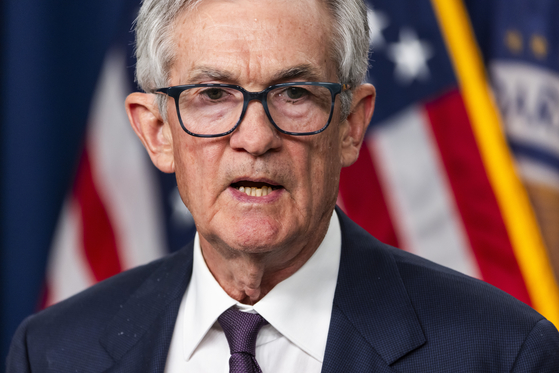U.S. Fed Warns of Escalating Economic Risks Despite Keeping Rates Steady

Jerome Powell, who chairs the U.S. Federal Reserve, declares that the central bank will keep interest rates unchanged after concluding their biennial policy meeting in Washington, D.C., on May 7, 2025. [EPA/YONHAP]
On Wednesday, the U.S. Federal Reserve decided to keep interest rates unchanged; however, they noted an increased risk of both rising inflation and higher unemployment, which adds more uncertainty to the future of the U.S. economy. This comes as officials at the Fed are trying to assess how President Donald Trump’s tariff policies will affect the situation.
At present, according to Federal Reserve Chairman Jerome Powell, it remains uncertain whether the economy will maintain its consistent rate of expansion or falter due to growing uncertainties and potential surges in inflation.
Given the numerous uncertainties surrounding Trump’s final decision and considering the potential outcomes after they undergo legal and political challenges, “the extent, magnitude, and longevity of these impacts remain highly unpredictable,” Powell stated during a press conference following a two-day policy gathering.
It’s entirely uncertain what the suitable approach for monetary policy should be right now... Truly, it’s completely unclear what actions we ought to take.
I don't believe we can predict how this will turn out.
Powell subtly indicated that the U.S. central bank, which plays a crucial role in economic development, was essentially being pushed aside as Trump’s comprehensive policy plan comes into play fully.
The Federal Reserve’s policy announcement maintained the target for the key interest rate within the 4.25% to 4.50% band without changes. It stated that following their previous gathering in March, “ambiguity regarding future economic conditions has grown,” with indications pointing towards escalating hazards of higher prices as well as joblessness.
Thomas Simons, who leads the U.S. economic team at Jefferies, indicated that the wording failed to fully capture the extent of the disruptions experienced since the Federal Reserve’s meeting on March 18-19, as well as the increasing unpredictability of the future scenario.
All the 'Liberation Day' tariff updates, the April 9 statement delaying measures for 90 days, the ongoing negotiations over trade agreements and tariff exceptions making front-page news, along with the pessimism reflected in both business and consumer polls, create an unclear picture regarding future economic prospects. It’s hard to determine even if the balance of risks associated with these predictions has shifted," Simons noted, describing Powell as "typically evasive" considering the circumstances.
The Federal Reserve’s statement, along with many of Powell’s remarks to journalists, affirmed the ongoing strength of the economy, noting continuous job creation and steady growth at a “robust rate.”
Powell mentioned that the recent drop in GDP for the initial quarter was distorted by an unprecedented surge in imports, as companies and families attempted to preempt anticipated tariffs. However, indicators of internal demand continued to show growth.
But even that data demonstrated the dilemma facing the Fed. The rush of front-loading to buy goods and stock shelves won't likely be repeated, and it is unclear whether underneath it all demand and investment are starting to weaken — and how that will eventually express itself in "hard" data on inflation and jobs. The Fed's own "Beige Book" of anecdotal reports about the economy recently gave a dour picture of suspended business deals, falling demand and rising prices.
Powell stated that both businesses and households are worried...and delaying numerous economic choices. He added that if these apprehensions persist without being eased, one could anticipate seeing this reflected in economic figures.
The Federal Reserve cannot react until it becomes evident which direction the economy will take, as well as how it perceives the risks associated with achieving its dual objectives: keeping inflation at 2 percent and maintaining full employment.
"Powell stated that the present position of monetary policy puts us in an optimal situation to promptly address any possible economic changes." He emphasized adopting a cautious strategy, which has turned into the hallmark of the central bank during the initial period under the Trump administration.
Following the release of the Federal Reserve’s unified policy statement, U.S. equity prices saw increased growth and ultimately closed higher for the day. There was a decline in treasury yields, whereas the dollar strengthened compared to various foreign currencies.
The course of Federal Reserve policy will hinge on how the risks related to employment and inflation evolve. In the more challenging scenario, if both inflation and unemployment rise simultaneously, forcing the central bank into a tough decision, they may have to prioritize one over the other when deploying monetary policy strategies.
If the job market weakens, it usually strengthens the argument for reducing interest rates; however, rising inflation would necessitate keeping monetary policies restrictive.
As of now, the Fed is maintaining a wait-and-see approach until some clarity emerges from the current uncertainties," explained Ashish Shah, who leads public investments at Goldman Sachs Asset Management. He further noted that recent employment figures have been stronger than anticipated, bolstering the Fed’s decision to hold off on action. However, he emphasized that significant weakening in the job market would be necessary before they consider restarting their easing measures.
The Federal Reserve’s interest rate has remained constant since December because policymakers are finding it challenging to gauge the effect of Trump's tariffs. These tariffs have increased concerns about rising inflation and potential deceleration in economic growth for this year.
When policymakers revised their economic and policy forecasts in March, they expected to lower the benchmark interest rate by 0.5 percentage points by the conclusion of this year.
Reuters
Posting Komentar untuk "U.S. Fed Warns of Escalating Economic Risks Despite Keeping Rates Steady"